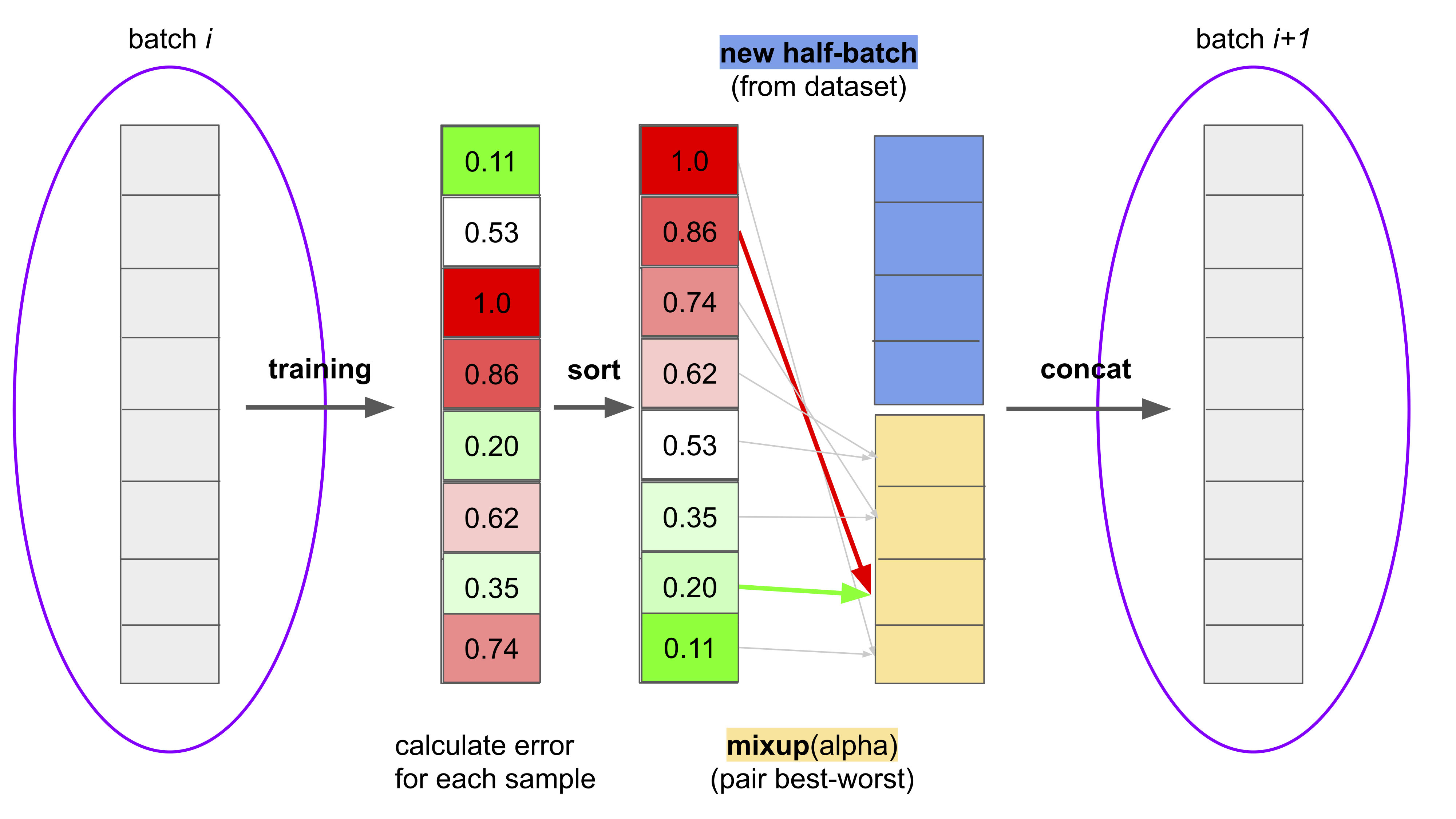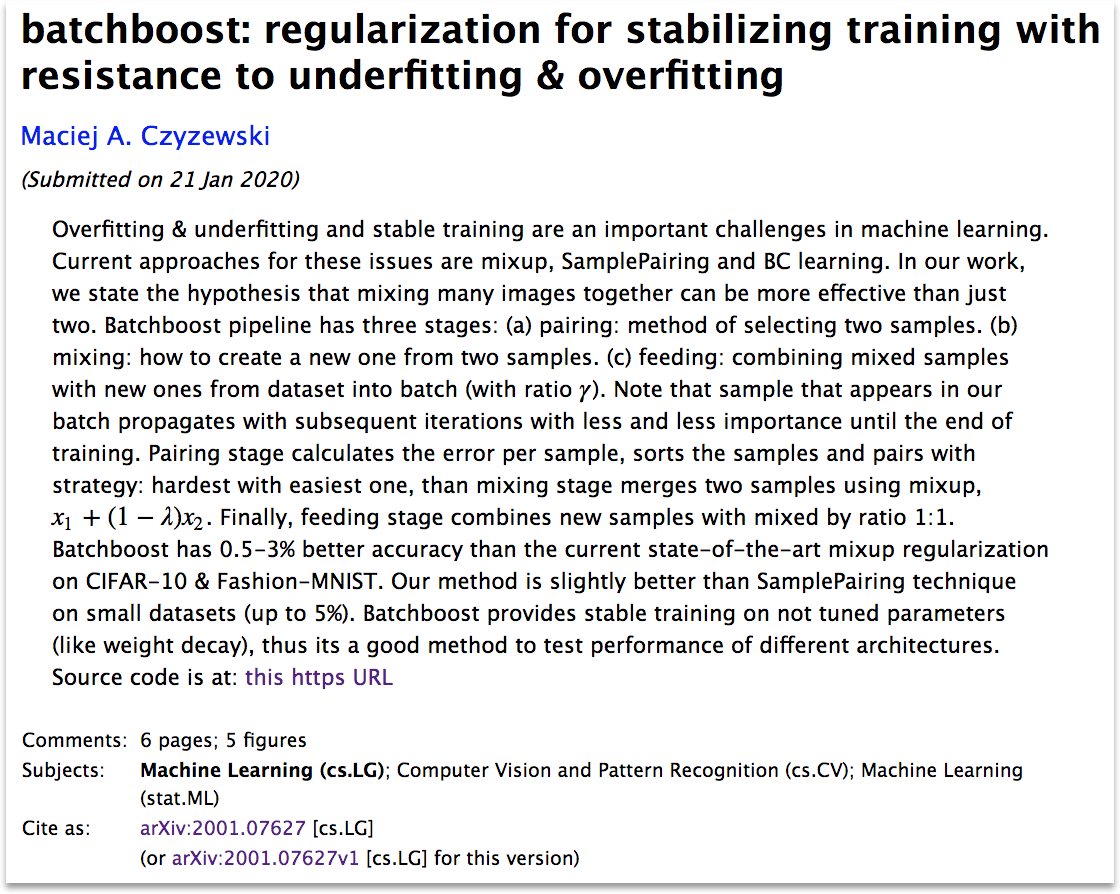maciejczyzewski / Batchboost
Programming Languages
batchboost (currently a draft)
This repository contains the implementation used for the results in our paper (https://arxiv.org/abs/2001.07627).
Batchboost is a simple technique to accelerate ML model training by adaptively feeding mini-batches with artificial samples which are created by mixing two examples from previous step - in favor of pairing those that produce the difficult one.
Introduction
UPDATE 24/01/2020: Thank you for your e-mails asking about batchboost. As promised, I will update the results soon and present comparisons with other solutions (paperswithcode.com). This is a draft and research needs to be continued to be complete work, if someone is interested in helping me, please contact.
Overview
In this research, we state the hypothesis that mixing many images together can be more effective than just two. To make it efficient, we propose a new method of creating mini-batches, where each sample from dataset is propagated with subsequent iterations with less and less importance until the end of learning process.
Batchboost pipeline has three stages: (a) pairing: method of selecting two samples from previous step. (b) mixing: method of creating a new artificial example from two selected samples. (c) feeding: constructing training mini-batch with created examples and new samples from dataset (concat with ratio γ). Note that sample from dataset propagates with subsequent iterations with less and less importance until the end of training.
Results
COMING: comparison of batchboost applied: to different architectures, to different problems (small datasets), for training GAN-s, with/without augmentation, with different parameters {window_normal, window_boost, factor} (hyperparameter tuning).
The results will be updated and saved to results/.
Underfitting & Stabilizing Training
Figure 1: Evaluation on CIFAR-10, for EfficientNet-b0 and SGD(weight-decay=10e-4, lr=0.1) (as recommended in the mixup research), same parameters for each model. As a result, the models behave differently, although they differ only in the method of constructing the mini-batch.
Overfitting (comparison to mixup)
Figure 2: batchboost is a new state-of-the-art because it is a slightly better than mixup (here mixup has been tuned for best parameters, batchboost uses configuration from Figure 1).
Requirements and Installation
- A computer running macOS or Linux
- For training new models, you'll also need a NVIDIA GPU and NCCL
- Python version 3.6
- A PyTorch installation
Training
Use python train.py to train a new model.
Here is an example setting:
# for batchboost
$ CUDA_VISIBLE_DEVICES=0 python3 train.py --decay=1e-4 --no-augment --seed=1 \
--name=batchboost --model=efficientnet-b0 --epoch=30
# for mixup
$ CUDA_VISIBLE_DEVICES=0 python3 train.py --decay=1e-4 --no-augment --seed=1 \
--name=mixup --model=efficientnet-b0 --epoch=30
Using
File batchboost.py should be portable, just copy into your path and write the following:
from batchboost import BatchBoost
# how to calculate error per sample?
def fn_error(outputs, targets):
logsoftmax = nn.LogSoftmax(dim=1)
return torch.sum(-outputs * logsoftmax(targets), dim=1)
# how to represent target in linear form (label -> one-hot)
def fn_linearize(x, num_classes=10):
_x = torch.zeros(x.size(0), num_classes)
_x[range(x.size(0)), x] = 1
return _x
# how to get back (one-hot -> label)
def fn_unlinearize(x):
_, _x = torch.max(x, 1)
return _x
BatchBoost.fn_error = fn_error
BatchBoost.fn_linearize = fn_linearize
BatchBoost.fn_unlinearize = fn_unlinearize
# if you don't want to train everything using `batchboost` method
# epoch: [... -> window_normal -> window_boost -> window_normal -> ...]
# ( batches ) ( batches ) ( batches )
BB = BatchBoost(
alpha=args.alpha, # alpha parameter for mixup
window_normal=0, # consecutive batch fits: normal
window_boost=10, # : batchboost
factor=1 / 2, # ratio between new information and feeded/mixed
use_cuda=True,
)
...
And slightly change your training loop:
...
for batch_idx, (new_inputs, new_targets) in enumerate(trainloader):
if use_cuda:
new_inputs, new_targets = new_inputs.cuda(), new_targets.cuda()
# -----> (a) feed with new information
if not BB.feed(new_inputs, new_targets):
continue
# -----> (b) apply concat: BB.inputs, BB.targets
outputs = net(BB.inputs)
# -----> (c) calculate: loss (mixup like style \lambda)
loss = BB.criterion(criterion, outputs)
train_loss += loss.data
_, predicted = torch.max(outputs.data, 1)
total += BB.inputs.size(0) # -----> remember to use concat
# -----> (d) calculate: accuracy
correct += BB.correct(predicted)
# -----> (e) pairing & mixing
BB.mixing(criterion, outputs)
...
Citation
If you find batchboost useful in your research, please consider citing:
@misc{czyzewski2020batchboost,
title={batchboost: regularization for stabilizing training with resistance to underfitting & overfitting},
author={Maciej A. Czyzewski},
year={2020},
eprint={2001.07627},
archivePrefix={arXiv},
primaryClass={cs.LG}
}
An interesting topic for further research and discussion are combination of batchboost and existing methods.
License
Implemented as fork of "mixup-cifar10 / facebook". This project is CC-BY-NC-licensed.







